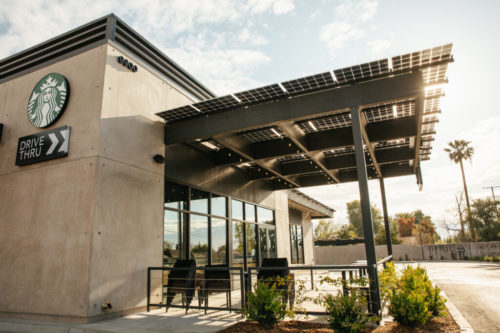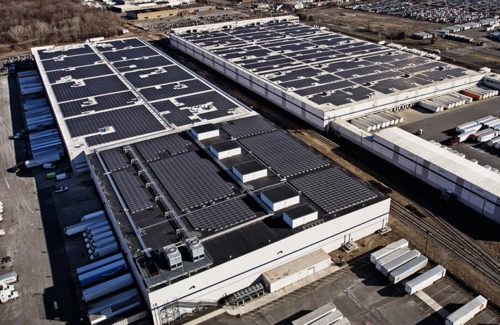The United States may have abandoned the Paris Agreement, an international treaty combatting climate change, but not everyone is silently standing by. More businesses and corporations are adopting progressive environmental goals, with solar investments at the top of their lists.

Solar panels on the new Starbucks store in the Northridge neighborhood of Los Angeles, California. Photo by Patrick T. Fallon for Starbucks
“Now more than ever, a company’s responsibility extends beyond caring for their economic impact to caring for their employees and the environment. This is coupled with the fact that solar is now the most competitively priced form of energy, giving businesses and public entities both an ethical and financial justification for investing in large solar projects,” said Eric Potts, senior VP for commercial in the Americas at SunPower. “The economic case is made even stronger by the new forms of income streams opened up using storage and community solar, providing excess energy to the grid and potentially offsetting lost revenues from the impacts of COVID-19.”
The latest “Solar Means Business” report from SEIA found that more corporations are making significant investments in renewable energy, with 1,283 MW of new commercial solar capacity installed in 2019 coming from commercial businesses. Over 65% of that number was on-site solar installations.
And while 2019 may have been big for on-site solar deployments, 2020 was huge for large-scale PPAs secured by corporations for off-site projects. SEIA predicts that an additional 5,000 MW of corporate off-site solar projects will come online over the next few years, which will more than double the total amount of corporate solar.
Some significant announcements from the last year:
- Google has signed a 140-MW PPA for a Texas project being built by Candela Renewables.
- Nestlé is receiving 100% of the power from a 250-MW Texas solar project developed by 7X Energy.
- Microsoft signed on for 500 MW of new solar through Sol Systems.
- McDonald’s has invested in 583 MW of solar in North Carolina and Ohio.
Many corporations have also committed to running their operations completely on renewables. Walmart plans to be 100% renewable by 2035. To date, the retail giant powers around 29% of its operations with renewable energy and is the third-largest corporation for installed solar in the United States. It is only surpassed by Apple and Amazon – companies with data centers that need a lot of power.

Pictured is a rooftop solar system installed at Amazon’s fulfillment warehouse in Avenel, New Jersey. P2 Photography
Amazon globally invested in 4 GW of new solar and wind projects in 2020 — the largest corporate investment in renewable energy in a single year.
“Amazon is helping fight climate change by moving quickly to power our businesses with renewable energy,” said Jeff Bezos, Amazon founder and CEO, in a press release. “We are on a path to running 100% of our business on renewable energy by 2025 — five years ahead of our original target of 2030.”
But what happens once a company reaches that coveted 100%? Do renewable energy investments stop? Not for Starbucks, which has sourced 100% renewable energy for its more than 9,000 U.S., Canadian, European, Middle Eastern and African company-operated stores since 2015. Now, the company is expanding its roster of renewable energy projects in the United States, supporting communities with large-scale solar and supplying the grid with energy storage. The coffee chain is investing $97 million in 23 community solar arrays in New York and is supporting a portion of a 2,165-MWh storage project being installed in California.
“We are well-positioned to invest in the right areas to strengthen our competitive advantage and drive consistent, sustainable growth for decades to come,” said Kevin Johnson, CEO of Starbucks, in a press release. “With Starbucks partners at our core, we believe our purpose extends far beyond the pursuit of profit, with an aspiration to positively impact the planet we all share and the people who connect with Starbucks.”





Nice article to read. Thanks for sharing.
Amén and Hallelujah, I’ve been after many a restaurant in Atlanta to do what this Solar Starbucks in Los Angles did! After all 99 times out of 100 the leafy green answer is the green dollar answer that will not only pay itself off but make money for decades to come!
And what a discovery about Semper Solaris in the comments above, as a US Marine trained on Parris Island in 1992, I was recently in the neighborhood and popped in for a visit! Low and behold my 1st Battalion Barracks are covered with about 50kW, as is the 1st Bn Chow Hall right next door! And if one goes there for a Platoon/Company Graduation they will undoubtedly he directed to park in the massive parking lot next to the Parade Deck….but parking in the sun will be a problem as it is covered with 200-300kW! All in all it is written that Parris Island has 5.5 Megawatts! Semper Solaris Indeed !
“The United States may have abandoned the Paris Agreement, an international treaty combatting climate change, but not everyone is silently standing by. More businesses and corporations are adopting progressive environmental goals, with solar investments at the top of their lists.”
Kind of dampens one’s enthusiasm for Agreements, pacts or other Diplomatic word spectacles as the actual path to change the status quo. This whole Paris Agreement thing, reminds me of awkward teenagers trying to court. Businesses are catching on, without a political push. The way the retail electricity market is formulated, most ratepayers are getting stuck in TOU or demand charge rate schedules that spike their electricity costs over the month. Businesses can save 30 to 50% on their electric bills just by generating their own power during these “demand charge periods”.
This line! “Now more than ever, a company’s responsibility extends beyond caring for their economic impact to caring for their employees and the environment. This is coupled with the fact that solar is now the most competitively priced form of energy, giving businesses and public entities both an ethical and financial justification for investing in large solar projects,”
This is 100% accurate and it’s great to see Major companies such as Starbucks finally make a stand to not only help the environment, but educate others on the way we should be generating electricity. More companies should hopefully follow and we will see a much cleaner future.